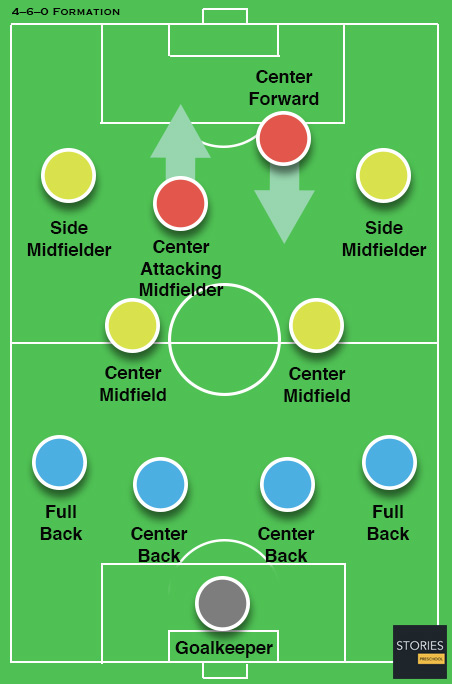Soccer

4–6–0 Formation
A highly unconventional formation, the 4–6–0 is an evolution of the 4–2–3–1 in which the centre forward is exchanged for a player who normally plays as a trequartista (that is, in the 'hole'). Suggested as a possible formation for the future of football, the formation sacrifices an out-and-out striker for the tactical advantage of a mobile front four attacking from a position that the opposition defenders cannot mark without being pulled out of position. Because of the intelligence and pace required by the front four attackers to create and attack any space left by the opposition defenders, however, the formation requires a very skillful and well-drilled front four. Due to these demanding requirements from the attackers, and the novelty of playing without a proper goalscorer, the formation has been adopted by very few teams, and rarely consistently.

As with the development of many formations, the origins and originators are uncertain, but arguably the first reference to a professional team adopting a similar formation is Anghel Iordănescu's Romania in the 1994 World Cup Round of 16, when Romania won 3–2 against Argentina. The first team to adopt the formation systematically was Luciano Spalletti's Roma side during the 2005–06 Serie A season, mostly out of necessity as his "strikerless" formation, and then notably by Alex Ferguson's Manchester United side that won the Premier League and Champions League in 2007–08. The formation was unsuccessfully used by Craig Levein's Scotland vs Czech Republic to widespread condemnation. At UEFA Euro 2012, Spain coach Vicente del Bosque used the 4–6–0 for his side's 1–1 group stage draw versus Italy and their 4–0 win versus Italy in the final of the tournament.
SPORTS

RESOURCES
This article uses material from the Wikipedia articles "Association football" and "Formation (Association football)", which is released under the Creative Commons Attribution-Share-Alike License 3.0.
© Stories Preschool. All Rights Reserved.












